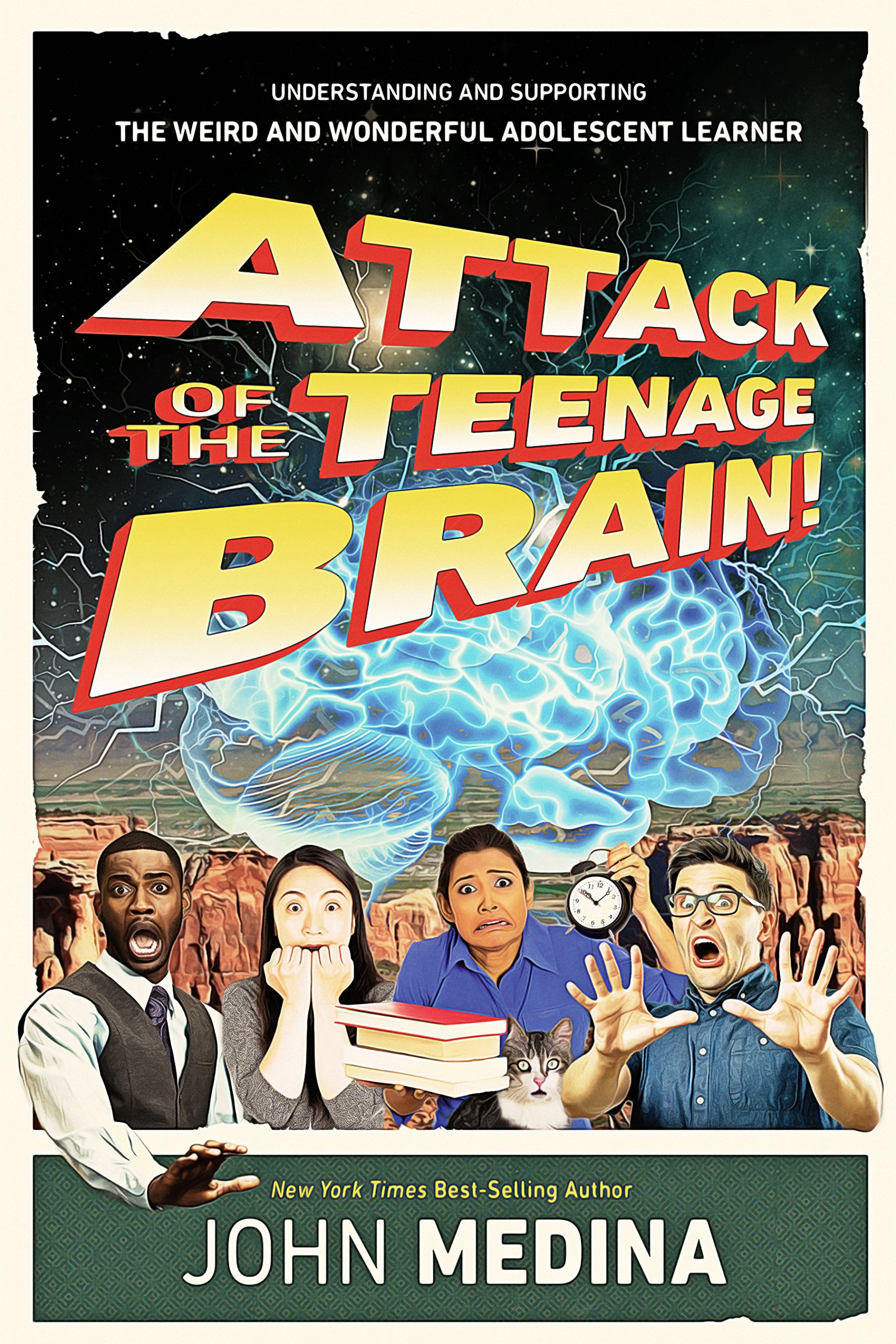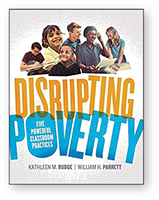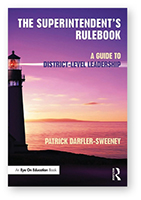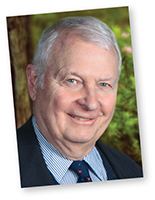
Reading & Resources
School Administrator, February 2019
Book Reviews
 Attack of the Teenage Brain!: Understanding and Supporting the Weird and Wonderful Adolescent Learner
Attack of the Teenage Brain!: Understanding and Supporting the Weird and Wonderful Adolescent Learner
by John Medina, ASCD, Alexandria, Va., 2018, 224 pp., $28.95 softcover
The central thesis of
Attack of the Teenage Brain! is that the teenage brain is still developing. This book gives a thorough review of brain development. It begins with the marshmallow experiment at Stanford University in the 1960s. The significance of delayed gratification was the key takeaway from the marshmallow experiment. Author John Medina introduces executive function from the marshmallow experiment. Executive function is the ability to manage oneself and one’s resources to achieve a goal. Medina identifies executive function as the key to school improvement for teens. Students with high executive function (ability to delay gratification) perform better in all aspects of school and life — academic and behavioral.
The book should begin with Part III – A better school for the teen brain. Medina says school should begin at 10:00 a.m. for teens because it allows more time for sleep, a critical piece of teen development. The book gives practical advice for schools and parents. The author recommends schools adopt social-emotional learning programs. He also states the importance of physical exercise and thinks the gym should be the center of the school.
Medina recognizes the importance of a school-parent partnership. He identifies and describes different parenting styles – authoritarian, authoritative, indifferent and indulgent.
Attack of the Teenage Brain! is an interesting read that offers practical suggestions to improve schools for teenagers. This book may be more appropriate for assistant superintendents responsible for curriculum and programs.
Reviewed by Roger Prosise, consultant, Ray and Associates, Chicago, Ill.
 Disrupting Poverty: Five Powerful Classroom Practices
Disrupting Poverty: Five Powerful Classroom Practices
by Kathleen M. Budge and
William H. Parrett, ASCD, Alexandria, Va., 2018, 183 pp. with index, $31.95 softcover
In
Disrupting Poverty, Kathleen Budge and William Parrett build on their earlier works involving childhood poverty and public education. Using multiple avenues of research, the authors build a blueprint for individual educators and school systems to “disrupt” the imbalance childhood poverty can create.
While the authors hesitate to call it a “how-to” book, it has all the hallmarks of one. Filled with charts, matrices and examples, it provides the building blocks to teaching with a purpose.
The book breaks down individual strategies to deal with our students in poverty. This synopsis is enhanced by practitioners in the field and real-life examples. It also includes anecdotal stories from individuals who have escaped poverty and issues that impacted/supported them along the way.
This book is written for teachers and principals, but anyone in the educational system could benefit from reading it. This is also a book that should not be read in isolation; it would be a great choice for a book study or an undergraduate course in teaching. It challenges preconceived notions about students in poverty.
Reviewed by Rob Clark, superintendent, Milton-Freewater Unified School District, Milton-Freewater, Ore.
 Leadership Matters in the Education of Students with Special Needs in the 21st Century
Leadership Matters in the Education of Students with Special Needs in the 21st Century
edited by Festus E. Obiakor, Tachelle Banks, Anthony F. Rotatori and
Cheryl Utley, Information Age Publishing, Charlotte, N.C., 2017, 209 pp., $45.99 softcover
Leadership Matters is an academic book citing many references and research findings that take a deep look at the leadership practices the four editors have found to be most effective in addressing special needs learners and students in general. They recognize that there are no quick fixes and talk about “the growing field of implementation science,” which finds that the innovation process can take two to four years or more. The process includes multiple decisions, actions and corrections before a program is successfully implemented and operational.
The editors open the book with the message that school leaders need to shift their paradigms and realize that “school leadership is second only to teacher quality in terms of importance.” They lay out practical suggestions to empower school leaders, which they say are “school personnel who are willing to help themselves and others do the right things.”
They suggest that one key is to build teams that include special education teachers and specialists, general teachers, psychologists, site administrators and district administrators who co-learn the most effective methods and develop these elements to reach CLD students. Empowered by what they have learned, culturally responsive school leaders will then be able to do the necessary transformative work on building trust, engaging personal culture, confronting issues of social dominance and social justice, transforming instructional practices and engaging the entire school community.
Although much of what is presented can be applied to all students, the editors put special emphasis on the challenges and rewards of specifically addressing the needs of special needs students and students who are CLD (culturally and linguistically diverse). In one chapter, Cheryl Utley points to “compelling research to suggest that broader, social, political, and economic systems are ‘hard wired’ to perpetuate inequities based on race and class.” The importance of overcoming those inequities and misperceptions is amplified by 2016 research projecting that, by 2020, 47 percent of students in the United States will be an ethnic, cultural or language minority.
Reviewed by Bob Schultz, adjunct professor and co-chair of Brandman University School of Education advisory board, Sacramento, Calif.
 Learning Time: In Pursuit of Educational Equity
Learning Time: In Pursuit of Educational Equity
edited by Marisa Saunders, Jorge Ruiz de Velasco and
Jeannie Oakes, Harvard Education Press, Cambridge, Mass., 2017, 288 pp., $33 softcover
In 1963, J. B. Carroll’s seminal work on the model of school learning was published and was one of the first publications to draw attention to the issue of academic time being spent in schools to meet student academic achievement needs. Not to trivialize the importance of this work, or the follow-up investigations by Bloom and Berliner, Carroll rocked the academic world by suggesting that learning is a function of time spent, divided by time needed. Thus, if a student needs four units of instruction, yet only receives one unit of instruction, they would be receiving 25 percent of the required amount of instructional time necessary for them to achieve the content.
In their edited book,
Learning Time: In Pursuit of Educational Equity, Marisa Saunders, Jorge Ruiz de Velasco and Jeannie Oakes have assembled a nice collection of work where the authors focus on various aspects and needs of academic learning time of students in educational programs from a teaching and learning perspective. The authors focus on salient policy, theoretical, practical, technical, pedagogical and instructional-design issues, covering topics and content in the areas of teacher empowerment, schedule, expanded learning opportunities beyond the school day, lifelong-learning post-school, innovation and differentiation of supports.
Real-world vignettes and case studies demonstrate theoretical and organizational initiatives and provide insights through examples into the realities of programs, highlighting the impact the interventions have had on student achievement and engagement. The proactive stance presented by the authors in the face of their programmatic realities and limitations provides support, modeling and motivation for others in similar situations. These programs are leading by example; administrators in similar situations would do well to learn from their experiences.
This text provides a wonderful starting point for administrators and professional learning communities wishing to start an introspective investigation into the learning needs of their constituents, and the impact that time has on the ability for students to succeed. I would suggest this text as a resource for any program wishing to pursue alternative or supplementary learning options for its students. It would provide a great deal of insight into some of the issues that might arise when implementing supplementary and differentiated instructional and teaching supports.
Reviewed by Mark E. Deschaine, associate professor, Department of Educational Leadership, Central Michigan University, Mount Pleasant, Mich.
 Rigor in Your School: A Toolkit for Leaders
Rigor in Your School: A Toolkit for Leaders
by Ronald Williamson and
Barbara R. Blackburn, Routledge, New York, N.Y., 2018, 256 pp. with index, $39.95 softcover
When the Common Core state standards were first developed, many in and outside of the educational world were seeking a way to increase the rigor for all students across the country. However, reaching a specified learning goal is not the definition of rigor for these authors.
Rigor in Your School: A Toolkit for Leaders is a tool to help educational leaders explore the topic of rigor in their school. Ronald Williamson, professor of Educational Leadership at Eastern Michigan University, and Barbara R. Blackburn, educator and author, have written a book that takes the reader beyond a simplistic vision of rigor, providing information and collaborative tools to build a culture that supports increased academic expectations for all students.
The book begins by discussing rigor and presenting activities for leaders to engage their staffs in the topic. The authors want the participants to explore their personal view of rigor and then, with their staffs, create a definition and vision for the school or district.
Williamson and Blackburn do a good job of presenting staff activities designed to build a deeper understanding of where the school currently is regarding the level of rigor. The activities deal with examining the culture and ownership for the vision, and managing data. Chapter 6 deals with professional development and utilizes strategies reflective and familiar to most while shifting the focus to rigor and ways to increase it within one’s own classroom.
When discussing advocacy, accountability and school structures, the authors continue to provide interesting activities that can be analyzed for a collective school summary, while holding all within the organization accountable to achieve the group/school goal.
Rigor in Your School is an interesting read for leaders looking to increase academic expectations in their school. The text reads like a presenter’s training notes – while the handouts are helpful, a bit more insight regarding implementation and analysis of the data collected would be helpful. For any school or district leader who has tackled a professional development topic as complex as rigor, this book makes it seem too easy. For an organization that is just starting to work on the topic of rigor, the activities outlined in this book would entail at least a year-long commitment. Video resources would be helpful to see how conversations among staff progressed. If rigor isn’t new to the group and a leader wants to further increase the focus on academic grit and remind staff not to become complacent, this book is certainly worth reading for ideas to engage the staff.
Reviewed by Edythe B. Austermuhl, superintendent, Berlin Township School District, West Berlin, N.J.
 The Superintendent's Rulebook: A Guide to District-Level Leadership
The Superintendent's Rulebook: A Guide to District-Level Leadership
by Patrick Darfler-Sweeney, Routledge, New York, N.Y., 2018, 194 pp., $34.95 softcover
In
The Superintendent's Rulebook: A Guide to District-Level Leadership, former superintendent of Hunter-Tannersville Central School District in Tannersville, N.Y., and adjunct professor at the State University of New York at Oneonta, Patrick Darfler-Sweeney provides a first-person account of his experiences as a superintendent and rules to help guide boards of education and new or aspiring superintendents.
District leaders will recognize all 132 rules as common sense and may or may not agree with some seemingly strong statements and opinions about accountability, teaching and assessment. However, Darfler-Sweeney encourages teacher and student input in collaborative deliberation and decision-making. There is no confusion that he was a superintendent and Darfler-Sweeney attempts a connection with readers by providing personal tidbits of information sprinkled throughout the text. At times, it seems that one is sitting down with a mentor for a cup of coffee.
Darfler-Sweeney organizes the book into three parts with the overarching themes of Human Resources, Political Realities, and Lighthouse (Leadership). Discussion questions at the end of each chapter provide a structure for personal reflection and in-box scenarios render a framework for realistic table-top discourse. Wherever district leaders may be in the sojourn toward the superintendency, this book offers reasonable insight into the challenges that are likely to be faced.
Reviewed by Lisa M. Antunes, assistant superintendent, Hillsborough Township School District, Hillsborough, N.J.
Why I Wrote this Book ...

“The disconnect between the professed social justice values of our profession and those expressed by a supposedly well-respected sub-urban superintendent who spewed racial epithets in his text messages with another administrator prompted me to hold two seminars for school leaders focusing on these blatant racist texts. At these, I discovered several administrators felt the racial comments were little more than ‘locker room’ talk. This indicated to me that the national core values contained in our nation’s founding documents are not deeply internalized by some educators. … The publisher of Rowman & Littlefield invited me to write a book in 2009. This now is the second edition. Unfortunately, what has not changed over 10 years is the hatred — it has gotten worse as evidenced by the continued mass shootings in schools and acts of hatred found elsewhere.”
Terrance L. Furin, affiliate professor, St. Joseph’s University, Philadelphia, Pa., and AASA member since 1984, on writing
Combating Hatred: Transformational Educators Striving for Social Justice 2nd edition (Rowman & Littlefield, 2019)
ABSTRACT
Turbulent Superintendencies
A doctoral study completed for an Ed.D. in 2018 by John Kopicki at Temple University examined sources of turbulence and factors that superintendents claim impact their job satisfaction.
His mixed-method study analyzed 500 Pennsylvania superintendents to help both current and future superintendents more deeply comprehend the impact such turbulence has on their profession.
Most superintendents claim a high level of job satisfaction while navigating in the obvious turbulent environments they live in every day, the researcher said. It is this combination of job satisfaction and turbulence that the study discussed.
“The Superintendency: A Turbulent Profession” is accessible from ProQuest at 800-521-0600 or
disspub@proquest.com.
BITS & PIECES
Poverty and School
A study from NWEA found evidence to suggest reliance on student achievement measures to evaluate school performance fails to recognize schools that are producing growth, especially in schools with high rates of poverty.
College Choice
More than 23,000 9th graders were surveyed in 2009 and again in 2012 about choosing a college after high school.
The report from the National Center for Education Statistics found that academic quality and reputation, a desired program of study, and job placement topped the list of important factors.
Educational Setting
The most frequently cited reasons for high school students transferring or becoming homeschooled were personal or family reasons, according to
a report from the National Center for Education Statistics.
Career Education
The MDRC has published
a paper offering an overview of research evidence supporting various types of career and technical education programs. The report documents how CTE programs improve students’ outcomes and lead to increased wages.
AASA Elections
Ballots for the AASA presidency are being distributed on Feb. 15 to all members in AASA’s active membership category. Voting must be completed on or by March 8.
The individual elected to serve as AASA president-elect in 2019-20 will be announced on the association’s website on March 12.
Kindness Challenge
AASA is a lead partner in the Middle School Kindness Challenge, a free curriculum for social and emotional development and improved school climate for grades 5-8. The curriculum includes four content pathways involving peer relationships, positive mindsets, empathy development and “cyber kindness.”
To sign up, visit
www.aasa.org/middleschoolkindness.aspx.
AASA Leadership Network
The
AASA Leadership Network (formerly Leadership Services) section of AASA’s website recently adopted a fresh look and better navigation. Visitors can easily discover the full array of 30-plus professional learning and networking programs hosted by AASA and identify session types (certification, academy and cohort) and experience levels (aspiring, new, experienced).